Abstract
In the ever-changing climatic conditions, it has become important to enhance rice productivity to ensure global food security. Drought is one of the major limiting factors in rice pro- duction. Drought during the reproductive stage results in maximum or complete yield loss. Efforts have been taken to develop drought-tolerant rice lines by introgressing three major drought-effect QTLs, viz. qDTY1.1, qDTY2.1, and qDTY3.1, from Apo into a susceptible popular rice variety, Improved White Ponni (IWP). Backcross inbred lines of IWP × Apo were developed through the marker-assisted backcross breeding approach. Foreground analysis using linked markers resulted in the identification of 17 progenies carrying two or more QTLs, and the recurrent parent genome recoveries of these lines were >95.6% using 72 genome-wide SSR markers distributed throughout all chromosomes. Upon phenotypic evaluation of 17 IWP BILs, the water limited condition resulted in the identification of improved lines by recording the yield and the yield-related parameters. The promising performance of IWP BILs in terms of spikelet fertility (63.3%) and grain yield per plant (>10 g) under drought stress indicated the positive effects of introgressed qDTYs, while IWP recorded complete yield loss (94.2%). Out of the cultivars considered, the best-performing lines which truly exhibited drought tolerance, with more increased yield than the recurrent parent under water-limited conditions, and the effects of these QTLs and their interactions were examined in this research work.
1. Introduction
Climatic conditions have drastically changed in recent years. As a result, unpredictable rainfalls and extreme temperatures occur, putting crops under several stress conditions and impacting their production. Climate change, especially drought, is emerging as a major challenge for sustainable rice production and food security [1,2]. In general, 3000 L of water are required to produce 1 kg of rice grain. Being a highly water-demanding crop, drought largely affects the physiological functions of the rice plant. Some of the disadvantageous yield traits found in the rice plant include low tiller number, lower number of panicles, and high number of sterile spikelets, even at low temperatures, depending on whether the drought occurs during the vegetative or reproductive stage of the crop. To be specific, lowland rice is highly sensitive to drought stress during the reproductive stage. In case of persistent drought, the crops cannot be recovered, resulting in complete yield loss. Under severe drought conditions, most of the high-yielding varieties suffer from complete yield loss. However, in recent studies, it was found that the introgressed lines of drought QTLs yielded 0.8–1.0 t ha−1 [1], and the most logical approach to overcome the effects of drought is to develop drought-tolerant, high-yielding, and good-quality rice varieties.
Drought tolerance is a complex trait exhibited by different types of genes across the genome. The studies conducted at the IRRI (International Rice Research Institute) led to the identification of drought-tolerant donors like N22, Dagad Deshi, Moroberekan, Aus 276, Vandana, Apo, and IR55419-04. Appropriate modifications in root and leaf traits were shown to improve some of the morpho-physiological adaptations of rice to drought, such as delayed leaf rolling and drying and reduced water loss through transpiration [3,4]. Low-stomatal density rice lines use only 60% of the normal water requirement to survive under drought, and the stomatal size, development, and adjustment of stomatal apertures also vary based on the environment to optimize CO2 uptake for photosynthesis [5,6]. Plants with increased bulliform cells and size and increased vascular bundle size show greater drought tolerance and high grain filling [7,8]. Additionally, under prolonged drought, tightening occurs in tissues that are important for structural integrity, whereas loosening occurs in tissues that must be kept expanding and metabolically active [9]. Leaf rolling is a defense mechanism against drought that reduces light-induced damage [10]. Plants with greater root hydraulic conductivity with increased root length and density at depth play a major role in maintaining plant water status under drought [11].
In rice, the major QTLs that govern the drought tolerance are as follows: qDTY1.1 [12], qDTY2.1, and qDTY3.1 [13]. These QTLs have been proven to increase the grain yield under drought conditions. Such QTL regions harbor genes that control the traits that are affected during drought conditions. qDTY1.1 was found to be associated with plant height, harvest index, and biomass across the N22/Swarna and N22/MTU1010 populations, while qDTY3.1 promotes early flowering [14], which in turn overcomes the drought stress.
Through MABB (marker-assisted backcross breeding) of the drought QTLs, many rice varieties have been developed to be drought-tolerant [15,16,17,18,19,20]. For lowland rice, a suitable drought-tolerant variety should be high-yielding, medium-to-long duration for high tillering, and should be a dwarf plant to minimize the lodging [21]. Improved White Ponni, a lowland high-yielding rice variety, together with BPT 5204, accounts for a cropping area of about 10 lakh hectares, representing 50% of Tamil Nadu’s total rice area [22]. Improved White Ponni is cultivated extensively in the Cauvery Delta Zone (Tamil Nadu-1), particularly in the districts of Pudukottai, Perambalur, Villupuram, Thiruvannamalai, and Thiruvallur, as well as in the Kallakurichi district (Tamil Nadu-2) [23], due to its high tillering ability, high yield per plant, and excellent slender grains with excellent cooking quality, but it is sensitive to drought conditions. In the current study, the drought-tolerant QTLs (qDTYs) were pyramided, with the help of stepwise marker-assisted pyramiding into Improved White Ponni with the following objectives: (i) to improve its yield under drought and (ii) and to understand the effects of different QTLs in enhancing the yield with Improved White Ponni.
2. Materials and Methods
2.1. Plant Materials
Improved White Ponni is one of the popular rice varieties in Tamil Nadu, which is partially resistant to rice tungro and blast diseases. However, it is highly sensitive to water-deficient stress; hence, it is used as a recurrent parent. Apo, a traditional upland rice variety harboring three major drought-tolerant QTLs [13,24] (Table 1), was used as a donor parent for the current study.

Table 1.
Details of markers used for foreground selection.
2.2. Development of IWP BILs Harboring Mega-Effect Drought-Tolerant QTLs from Apo through MABB
IWP BILs were developed using the marker-assisted backcross breeding scheme (Figure 1). Fresh leaf samples were collected, and DNA was isolated by following the modified CTAB method [25]. DNA fragments were quantified using a nanodrop spectrophotometer (ND 1000, Wilmington, DE, USA), and polymerase chain reaction (PCR) products were separated in 3% agarose gel electrophoresis. DNA profiles from such markers were scored in comparison with their parents. The foreground selection was carried out using three SSR markers, such as RM472, RM240, and RM520 (Table 2). These markers are linked with the target QTLs, viz. qDTY1.1, qDTY2.1, and qDTY3.1, respectively. A total of 72 genome-wide SSR markers, spanning all 12 chromosomes, were used for the background selection (BGS) process.
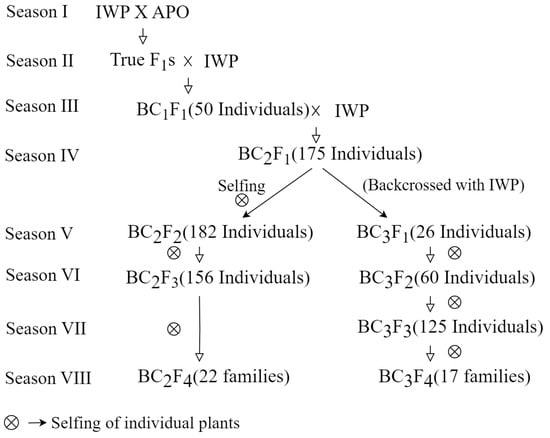
Figure 1.
Marker-assisted backcross breeding scheme for the development of drought-tolerant rice IWP pyramided with drought-tolerant QTLs.

Table 2.
Sequence details of the markers used for the foreground selection process.
2.3. Phenotypic Evaluation of IWP BILs under Water Deficit Conditions
Lowland and drought trials were conducted at the Paddy Breeding Station, Coimbatore (10.9953° N, 76.9165° E). The lowland trials were conducted under puddled transplanted conditions. The 25-days-old seedlings were transplanted with the spacing of 30 cm × 20 cm, and the blanket recommendation of 150:50:50 kg NPK/ha was applied. A basal of 16.6 kg/ha K was applied at the time of transplanting; first top dressing (50 kg/ha N) was applied at 15 days after planting, the second top dressing was applied at the panicle initiation stage (50 kg/ha N and 16.7 kg/ha K), and the third top dressing was applied at the heading stage (50 kg/ha N and 16.7 kg/ha K). For the drought trial, the seeds were directly sown on puddled soil. After the emergence of the seedlings, the plants were maintained under well-irrigated conditions until the 61st day. Before the onset of booting, drought stress was imposed on the 62nd day by withdrawing the irrigation completely, and the condition was maintained until the crop was harvested. A soil sample (500 g) was taken to estimate the final soil moisture content (SMC) at 15 cm, 30 cm, 45 cm, and 60 cm depths in six areas of the drought-stressed field (Figure 2) during the grain-filling stages at 115 DAS.
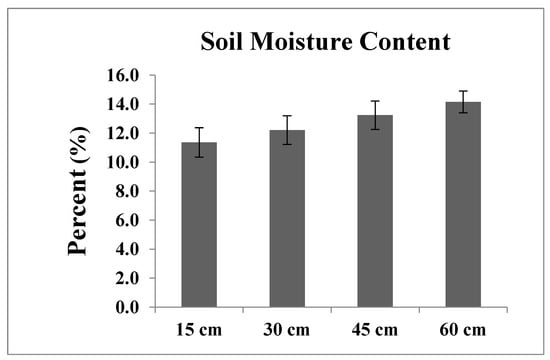
Figure 2.
Final soil moisture content during drought stress taken at six different areas in the rain-out shelter.
Days to flowering (DTF) was recorded when 50% of the plants were in the flowering stage. After maturity, during the harvest time, the tillers bearing panicles were counted as the number of productive tillers per plant (PT), and other data were also recorded from ten plants, such as the number of filled grains per panicle (FG), number of chaffy grains per panicle (CG), grain yield (GY), and thousand grain weight (TGW), from which their average values were taken for further analyses. The grain yield value was considered on a single-plant basis.
Photosynthetic indicators, viz. photosynthetic rate (Pn), transpiration rate (E), and stomatal conductance (gS), were recorded from the fully-expanded flag leaves of five tagged plants under a clear sunny day between 10.00 a.m. and 12.00 p.m. using the portable photosynthetic system (ADC Bioscientific Ltd., Hoddeston, Herts, UK).
The grains of both the BILs and the IWP were evaluated for grain quality traits. Both the length and breadth of the milled rice grains were measured using vernier caliper, and the length: breadth (L/B) ratio was calculated. The gel consistency was measured [26] by heating the solution (95% ethanol containing 0.025% thymol blue and 2 mL of 0.2 N KOH added to 100 mg of the rice flour in 13 mm × 100 mm culture tubes) for 10 min in a boiling water bath and then cooled for 20 min in ice. After 30 min, the length of the cold gel, held in test tubes horizontally, was measured using a graph paper. The time required for cooking was determined by the gelatinization temperature (low—55 °C to 69 °C, intermediate—70 °C to 74 °C, and high >74 °C) using the alkali digestibility test. The whole polished rice grains, immersed in 10 mL of 1.7% KOH in the petriplates, were kept for 23 h. The alkali-spreading values of the kernels were classified as low, intermediate, and high [27].
3. Results
3.1. Development of Backcross Inbred Lines (BILs) of IWP Pyramided with Drought-Tolerant QTLs
The parents were crossed, and the true F1s were identified using the linked markers. F1s shows the amplified alleles of both the parents (heterozygous) at each qDTY (drought yield quantitative locus) and were backcrossed with the recurrent parent. A total of 14 BC1F1 individuals that harbored the donor alleles (Table 3) for any two target loci were used to generate the BC2F1. In BC2F1, 34 individuals with a minimum of two qDTYs and morphological characteristics like IWP were backcrossed to generate the BC3F1. At the same time, the FGS in BC2F2 revealed that 43 lines were homozygous for one or two qDTYs (Figure 3). However, only four individuals were selected with similarity to IWP. In BC2F3, 52 individuals were homozygotes at different qDTY loci. However, only 22 BC2F3 individuals with different target qDTYs combinations had similar morphological characteristics like IWP. These lines were raised as the families of pyramided lines (PLs) and were genotyped using 72 background SSR markers. The results showed that they achieved a maximum genome recovery of 92% (Figure 4).

Table 3.
Backcross and the selfed progenies of rice, generated and genotyped during different cycles of backcross breeding.
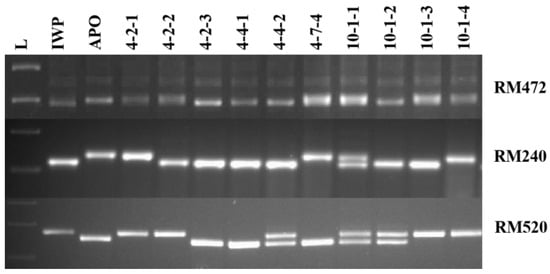
Figure 3.
Foreground selection in BC2F2 progenies using markers linked to target QTLs.

Figure 4.
Graphical representation of IWP BILs showing the extent of IWP genome recovery. The red color represents homozygous regions for Improved White Ponni (recurrent parent). The blue color represents homozygous regions for Apo (donor parent). Progenies—1: 10-1-1-5-23; 2: 4-7-4-24-3-4-12; 3: 4-7-4-24-3-4-15; 4: 4-7-4-24-3-4-17; 5: 4-7-4-24-4-16-28; 6: 4-7-4-24-4-16-29; 7: 4-7-4-24-4-16-30.
Similarly, 26 BC3F1 individuals (RPG % ~94–95%), which amplified the heterozygous alleles for the target loci, were selfed. Out of the total 60 BC3F2, 17individuals with one or two qDTYs, were forwarded to BC3F3. Further, a total of 125 BC3F3 individuals were raised, and 28 individuals amplified the homozygous alleles for two qDTYs (qDTY2.1 and qDTY3.1). Therefore, the 17 selected BC3F3 individuals were raised as the families of pyramided lines (PLs) and were genotyped with 72 background SSR markers. The outcomes showed a maximum genome recovery of 95.6%.
3.2. Identification of Elite Inbred Lines of IWP BILs Harboring Drought-Tolerant QTLs
To identify the superior progenies with similarity to IWP, we evaluated both BC2F3 and BC3F3 generations. Among the 156 BC2F3 and 125 BC3F3 progenies, those progenies with two target QTLs under homozygous condition were identified. Based on the yield quantity and grain type similarity, 22 families and 17 families were selected, respectively, for further drought screening. The drought-tolerant and superior BILs identified in the study were subjected to grain and cooking quality traits, as shown in Table 4 and Figure 5.

Table 4.
Grain and cooking quality traits of IWP BILs.
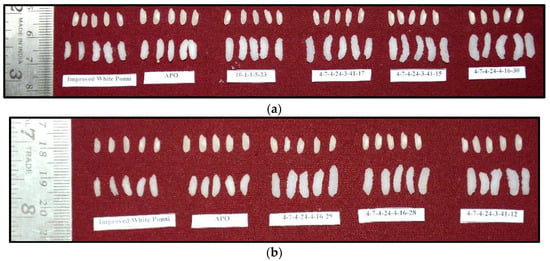
Figure 5.
(a) Comparison of the cooking quality of BILs with IWP–IWP, APO, 10-1-1-5-23,4-7-4-24-3-17, 4-7-4-24-3-15, and 4-7-4-24-4-30. (b) Comparison of the cooking quality of BILs with IWP–IWP, APO, 4-7-4-24-4-29, 4-7-4-24-4-28, and 4-7-4-24-3-12.
3.3. Measuring Responses of BILs for Drought Tolerance
The selected BC2F4 and BC3F4 BILs were evaluated for tolerance under drought conditions (Figure 6). Table 5 and Table 6 show the combined and individual yield performances of the seven most promising drought-tolerant IWP BILs. The recipient parent, i.e., IWP, either did not flower at all or produced a negligible yield. The differences in the DTF of IWP BILs and IWP under control and drought stress conditions were considerable. The IWP BILs were 22.9–26.9 days earlier under drought conditions and 8.6–13 days in the case of irrigated controls. The mean spikelet fertility of IWP BILs was higher (63.3%) than the IWP (25.2%) under drought stress (Figure 7). The grain yields (GY) of the selected IWP BILs were in the range of 11.4 g to 17.1 g under drought and 30.5–34.6 g per plant in the case of irrigated controls (Figure 8). The IWP produced negligible or no GY at all under drought (1.3 g). However, under control, the mean grain yield of the IWP was 24.2 g per plant (Figure 9).
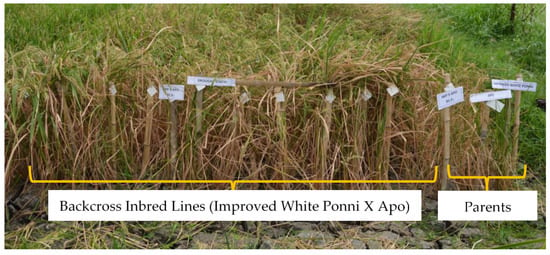
Figure 6.
Crop under drought stress condition in a rain-out shelter and soil cracks due to the severity of drought stress.

Table 5.
Agronomic performance of the IWP BILs in comparison with the recurrent parent IWP.

Table 6.
Differences in the agronomic parameters for the IWP and IWP BILs under drought stress and control conditions.
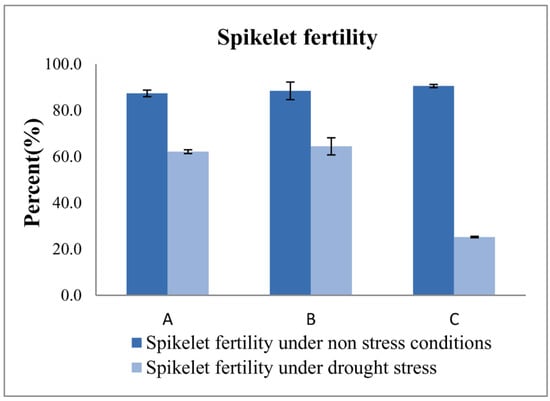
Figure 7.
Mean spikelet fertility of both IWP BILs and IWP. QTL combinations: A: qDTY1.1 + qDTY3.1; B: qDTY2.1+ qDTY3.1; and C: IWP.
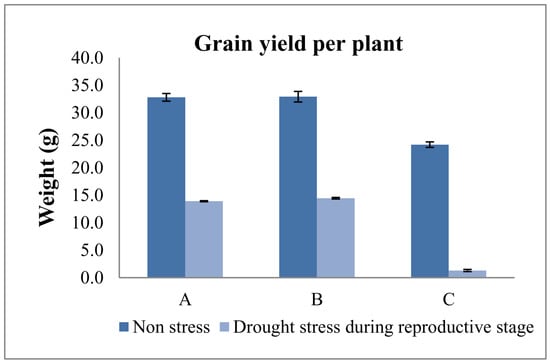
Figure 8.
Mean single plant yield of IWP BILs and IWP. QTL combinations: A: qDTY1.1+ qDTY3.1; B: qDTY2.1+ qDTY3.1; and C: IWP.

Figure 9.
Reduction (%) in the yield traits of QTL classes of IWP BILs. Days to flowering (DTF), number of tillers (NT), and GY (single plant yield); QTL combinations: A: qDTY1.1 + qDTY3.1, B: qDTY2.1+ qDTY3.1; and C: IWP.
Further, the gas exchange parameters were measured during drought stress. As expected, the drought treatment led to a significant reduction in various parameters, such as the net photosynthetic rate, stomatal conductance, and transpiration rate (Table 7). However, the photosynthetic rate was found to be constitutively higher in the IWP BILs than the IWP (Figure 10). It is important to note that a remarkably-high photosynthetic rate was achieved in these lines, despite transpiration and low average stomatal conductance (Figure 10) under drought.

Table 7.
Physiological performance of the BILs under drought stress.
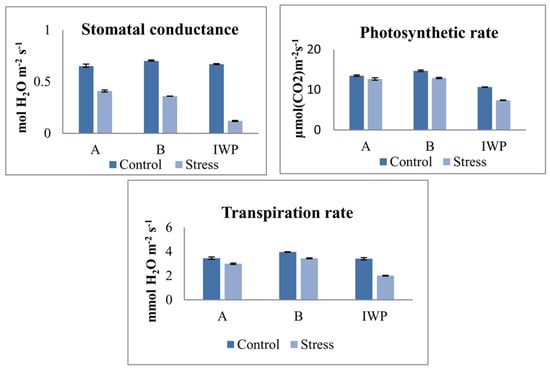
Figure 10.
Comparison of the physiological performance of the BILs with the recurrent parent IWP. QTL combinations: A: qDTY1.1+ qDTY3.1 and B: qDTY2.1 + qDTY3.1.
4. Discussion
Studies have outlined drought as a serious threat that may inhibit crop productivity. Plant breeders have made it their primary focus to introgress the drought-tolerant characteristic in all the cultivated rice varieties. Improved White Ponni, a widely-grown medium-duration rice (Aug–Jan), occupies the majority of the cropping areas in the Cauvery delta zone and is highly sensitive to drought conditions. Marker-assisted backcross breeding (MABC) has been identified as an effective and efficient strategy in crop improvement, as it speeds up and simplifies the selection process, especially in the case of complex traits [2,28]. Additionally, through MABC, within two to four backcrosses, the recurrent parent genome can be recovered [29]. The initial cost of using the markers poses a high limitation in utilizing marker-assisted backcross breeding. Nevertheless, there is great potential for the selection of genetic markers for MABC because molecular markers are consistent with any significant environmental influence [30,31]. Introgression of multiple drought-tolerant QTLs, which show consistent effects across environments, contribute to the successful development of drought-tolerant lines. In the current study, upland rice APO was used as a donor for these QTLs. The qDTYs (drought yield quantitative trait) used in the current study were found to be stable across populations and environments, with a significant positive impact on grain yield [13,24].
In upland rice, the linkage between drought tolerance and the undesirable traits has been well established. qDTY1.1 is linked with sd1 (semi-dwarf)-producing tall phenotypes [24], whereas, qDTY3.1 is identified with affecting the grain yield negatively, under non-stress conditions [32]. In a large population, there is an advantage of obtaining the genotypes without any undesirable linkages [33]. In this study, three backcrosses were performed to increase the recipient parent genome recovery up to 92–95.6%.
Drought stress was imposed on the backcrossed lines before flowering to ensure that even the lines with early flowering did not escape drought, and the selected lines were truly drought-tolerant.
The level of drought in drought stress was considered to be severe, based on the mean yield reduction value, if it was more than 50% higher than the NS. Soil developed deep cracks due to insufficient water moisture (Figure 6). The final gravimetric soil moisture content (SMC) was determined to be 7–16.4% in 15–60 cm depths, which indicates severe stress [34]. Additionally, if the drought-sensitive parent reduces its yield up to 60%, it can be considered an effective drought screening method [35]. IWP was extremely sensitive to severe reproductive-stage drought stress conditions, as it recorded an almost complete yield loss of 94.2% under drought in this study. However, IWP BILs were found to be less affected by drought. This might be attributed to the QTL alleles that tend to reduce the delay in flowering under stress conditions.
The yield increase in the BILs over IWP under drought was in the range of 88.6–92.4%. This indicates the positive effect of the introgressed qDTYs under drought.
The estimation of physiological parameters showed a reduction in the photosynthetic rates of all the entries, which could be attributed to low stomatal conductance under water stress. Better stomatal conductance of IWP BILs than the IWP translates into a higher photosynthetic rate of the drought-tolerant genotypes. This indicates the efficiency of the BILs at balancing CO2 uptake for photosynthesis while limiting the transpiration to improve water use efficiency under drought stress. qDTY1.1 is involved in ROS scavenging as a key mechanism in flag leaves and panicles of drought-introgressed lines [9], while qDTY3.1 contains two important genes for osmotic stress-protein detoxification and other genes primarily associated with redox reactions, transcription control, protein phosphorylation, transmembrane transport, and carbohydrate metabolism [36].
The mean comparisons of the qDTY classes show that the introgressed lines with both the combinations of qDTY achieved a significant yield increase over IWP under drought stress without any yield reduction in NS. This finding infers the positive effects of qDTY1.1, qDTY2.1, and qDTY3.1 in the IWP background in terms of increased yield under drought. The results further imply the necessity to identify qDTY combinations with positive interactions against different genetic backgrounds for their precise use in MAB.
In the current study, under NS conditions, the IWP BILs flowered earlier, compared to IWP, probably due to the association of alleles in qDTY1.1 and qDTY3.1 [35]. qDTY3.1 was identified to be co-localized with the hd-6 locus, which increases the days to heading [37,38]. However, the earliness did not cause a reduction in the grain yield under normal field conditions.
All six BC3F4 and one BC2F4 IWP BILs performed well in the non-stress trials. The comparative analysis conducted among the chosen BILs infers that all of them carried qDTY3.1 with either qDTY1.1 or qDTY2.1. These BILs recorded an increase in the yield up to 20.7–30.1%, compared to IWP under non-stress environments. All these BILs possessed grain qualities like IWP (Figure 5). This inference implies that QTL pyramiding using marker-assisted breeding technology is an effective method to improve the current mega-varieties and develop new rice cultivars that are tolerant of drought. Those lines with good yield potential and appreciable yield under drought can be effectively disseminated by the rice farmers for cultivation under drought-prone environments.
5. Conclusions
Drought is a major challenge in achieving sustainable rice production in the rain-fed ecosystems of Asia. Breeding drought-tolerant rice cultivars can increase the production of rice, especially in rain-fed ecosystems under drought stress. The identification and introgression of the QTL regions, with a large and consistent effect on GY during reproductive-stage drought stress, present an opportunity to improve high-yielding drought-susceptible mega-varieties through MABB. The selected IWP BILs developed in this study conferred a yield advantage of 88.6–92.4% over their recipient parent under drought conditions and maintained a high yield potential similar to or even higher than the IWP under NS. This finding infers that the drought tolerance can be successfully combined with high yield potential in the background of semi-dwarf varieties. The current study confirmed the positive interactions that occur among qDTY1.1, qDTY2.1, and qDTY3.1 for grain yield under drought conditions.
Supplementary Materials
The following supporting information can be downloaded at: https://www.mdpi.com/article/10.3390/agriculture14030431/s1, Table S1. List of SSR markers used for background selection; Table S2: Spikelet fertility of Parents and BILs.
Author Contributions
Conceptualization, project implementation, project monitoring: R.M. and M.S.; conceptualization, writing—review and editing, and funding acquisition: R.M.; investigation, formal analysis, and data collection: F.D.P.S., M.M. and B.A.; data collection: R.K. and V.M.; project monitoring, data curation, and formal analysis: V.R.R. and S.M.; funding acquisition and manuscript revision: R.M. All authors have read and agreed to the published version of the manuscript.
Funding
This research was funded by the Department of Plant Biotechnology, Government of India, New Delhi (Grant # BT/PR13454).
Institutional Review Board Statement
Not applicable.
Data Availability Statement
The background SSR markers data used in this study are available as a Supplementary Table.
Acknowledgments
The authors acknowledge CPMB&B and CPBG, TNAU for providing all the support for this study.
Conflicts of Interest
The authors declare no conflicts of interest.
References
- Dar, M.H.; Waza, S.A.; Shukla, S.; Zaidi, N.W.; Nayak, S.; Hossain, M.; Kumar, A.; Ismail, A.M.; Singh, U.S. Drought Tolerant Rice for Ensuring Food Security in Eastern India. Sustainability 2020, 12, 2214. [Google Scholar] [CrossRef]
- Oladosu, Y.; Rafii, M.Y.; Samuel, C.; Fatai, A.; Magaji, U.; Kareem, I.; Kamarudin, Z.S.; Muhammad, I.; Kolapo, K. Drought Resistance in Rice from Conventional to Molecular Breeding: A Review. Int. J. Mol. Sci. 2019, 20, 3519. [Google Scholar] [CrossRef] [PubMed]
- Barik, S.R.; Pandit, E.; Pradhan, S.K.; Mohanty, S.P.; Mohapatra, T. Genetic Mapping of Morpho-Physiological Traits Involved during Reproductive Stage Drought Tolerance in Rice. PLoS ONE 2019, 14, e0214979. [Google Scholar] [CrossRef] [PubMed]
- Khan, M.I.R.; Palakolanu, S.R.; Chopra, P.; Rajurkar, A.B.; Gupta, R.; Iqbal, N.; Maheshwari, C. Improving Drought Tolerance in Rice: Ensuring Food Security through Multi-dimensional Approaches. Physiol. Plant. 2021, 172, 645–668. [Google Scholar] [CrossRef] [PubMed]
- Caine, R.S.; Yin, X.; Sloan, J.; Harrison, E.L.; Mohammed, U.; Fulton, T.; Biswal, A.K.; Dionora, J.; Chater, C.C.; Coe, R.A.; et al. Rice with Reduced Stomatal Density Conserves Water and Has Improved Drought Tolerance under Future Climate Conditions. New Phytol. 2019, 221, 371–384. [Google Scholar] [CrossRef] [PubMed]
- Bertolino, L.T.; Caine, R.S.; Gray, J.E. Impact of Stomatal Density and Morphology on Water-Use Efficiency in a Changing World. Front. Plant Sci. 2019, 10, 225. [Google Scholar] [CrossRef]
- Liao, S.; Qin, X.; Luo, L.; Han, Y.; Wang, X.; Usman, B.; Nawaz, G.; Zhao, N.; Liu, Y.; Li, R. CRISPR/Cas9-Induced Mutagenesis of Semi-Rolled Leaf1, 2 Confers Curled Leaf Phenotype and Drought Tolerance by Influencing Protein Expression Patterns and ROS Scavenging in Rice (Oryza sativa L.). Agronomy 2019, 9, 728. [Google Scholar] [CrossRef]
- Salsinha, Y.C.F.; Maryani; Indradewa, D.; Purwestri, Y.A.; Rachmawati, D. Leaf Physiological and Anatomical Characters Contribute to Drought Tolerance of Nusa Tenggara Timur Local Rice Cultivars. J. Crop Sci. Biotechnol. 2021, 24, 337–348. [Google Scholar] [CrossRef]
- Tarun, J.A.; Mauleon, R.; Arbelaez, J.D.; Catausan, S.; Dixit, S.; Kumar, A.; Brown, P.; Kohli, A.; Kretzschmar, T. Comparative Transcriptomics and Co-Expression Networks Reveal Tissue-and Genotype-Specific Responses of qDTYs to Reproductive-Stage Drought Stress in Rice (Oryza sativa L.). Genes 2020, 11, 1124. [Google Scholar] [CrossRef]
- Xu, P.; Ali, A.; Han, B.; Wu, X. Current Advances in Molecular Basis and Mechanisms Regulating Leaf Morphology in Rice. Front. Plant Sci. 2018, 9, 1528. [Google Scholar] [CrossRef] [PubMed]
- Henry, A.; Swamy, B.M.; Dixit, S.; Torres, R.D.; Batoto, T.C.; Manalili, M.; Anantha, M.S.; Mandal, N.P.; Kumar, A. Physiological Mechanisms Contributing to the QTL-Combination Effects on Improved Performance of IR64 Rice NILs under Drought. J. Exp. Bot. 2015, 66, 1787–1799. [Google Scholar] [CrossRef] [PubMed]
- Vikram, P.; Swamy, B.M.; Dixit, S.; Ahmed, H.U.; Teresa Sta Cruz, M.; Singh, A.K.; Kumar, A. qDTY1.1, a Major QTL for Rice Grain Yield under Reproductive-Stage Drought Stress with a Consistent Effect in Multiple Elite Genetic Backgrounds. BMC Genet 2011, 12, 89. [Google Scholar] [CrossRef] [PubMed]
- Venuprasad, R.; Dalid, C.O.; Del Valle, M.; Zhao, D.; Espiritu, M.; Sta Cruz, M.T.; Amante, M.; Kumar, A.; Atlin, G.N. Identification and Characterization of Large-Effect Quantitative Trait Loci for Grain Yield under Lowland Drought Stress in Rice Using Bulk-Segregant Analysis. Theor. Appl. Genet 2009, 120, 177–190. [Google Scholar] [CrossRef]
- Varshney, R.K.; Tuberosa, R. Translational Genomics in Crop Breeding for Biotic Stress Resistance: An Introduction. In Translational Genomics for Crop Breeding; Varshney, R.K., Tuberosa, R., Eds.; Wiley: Hoboken, NJ, USA, 2013; pp. 1–9. ISBN 978-0-470-96290-9. [Google Scholar]
- Bhukya, J.N.; Bollineni, S.N.; Kadambari, G.; Bommisetty, R.; Gudikati, E.R.; Darsha, W.M.; Issa, K.; Akkareddy, S.; Eslavath, S.N.; Dokuparthi, A.K.; et al. Marker-assisted Introgression of QTLs for Yield under Moisture Stress into Elite Varieties of Rice (Oryza sativa). Plant Breed. 2020, 139, 1076–1089. [Google Scholar] [CrossRef]
- Dhawan, G.; Kumar, A.; Dwivedi, P.; Gopala Krishnan, S.; Pal, M.; Vinod, K.K.; Nagarajan, M.; Bhowmick, P.K.; Bollinedi, H.; Ellur, R.K. Introgression of qDTY1.1 Governing Reproductive Stage Drought Tolerance into an Elite Basmati Rice Variety “Pusa Basmati 1” through Marker Assisted Backcross Breeding. Agronomy 2021, 11, 202. [Google Scholar] [CrossRef]
- Dwivedi, S.K.; Arora, A.; Singh, V.P.; Singh, G.P. Induction of Water Deficit Tolerance in Wheat Due to Exogenous Application of Plant Growth Regulators: Membrane Stability, Water Relations and Photosynthesis. Photosynthetica 2018, 56, 478–486. [Google Scholar] [CrossRef]
- Muthu, V.; Abbai, R.; Nallathambi, J.; Rahman, H.; Ramasamy, S.; Kambale, R.; Thulasinathan, T.; Ayyenar, B.; Muthurajan, R. Pyramiding QTLs Controlling Tolerance against Drought, Salinity, and Submergence in Rice through Marker Assisted Breeding. PLoS ONE 2020, 15, e0227421. [Google Scholar] [CrossRef]
- Oo, K.S.; Krishnan, S.G.; Vinod, K.K.; Dhawan, G.; Dwivedi, P.; Kumar, P.; Bhowmick, P.K.; Pal, M.; Chinnuswamy, V.; Nagarajan, M. Molecular Breeding for Improving Productivity of Oryza sativa L. Cv. Pusa 44 under Reproductive Stage Drought Stress through Introgression of a Major QTL, qDTY12.1. Genes 2021, 12, 967. [Google Scholar] [CrossRef]
- Priyadarshini, S.K.; Raveendran, M.; Manonmani, S.; Robin, S. Effect of QTLs Controlling Grain Yield under Drought Stress in the Genetic Background of ADT45 Rice Variety. Indian J. Genet. Plant Breed. 2014, 74, 374–377. [Google Scholar] [CrossRef]
- Dixit, S.; Singh, A.; Kumar, A. Rice Breeding for High Grain Yield under Drought: A Strategic Solution to a Complex Problem. Int. J. Agron. 2014, 2014, 863683. [Google Scholar] [CrossRef]
- Shaik, N.M.; Arun Kumar, S.; Praveen, R.; Waris, A.; Voleti, S.R. Promising Technologies to Bridge the Rice Yield Gaps across the Country: Experiences from Frontline Demonstrations Program. J. Rice Res. 2018, 11, 73–80. [Google Scholar]
- ICAR-Indian Institute of Rice Research. Production Oriented Survey 2022. In All India Coordinated Research Project on Rice; ICAR-Indian Institute of Rice Research: Hyderabad, India, 2023. [Google Scholar]
- Venuprasad, R.; Bool, M.E.; Quiatchon, L.; Sta Cruz, M.T.; Amante, M.; Atlin, G.N. A Large-Effect QTL for Rice Grain Yield under Upland Drought Stress on Chromosome 1. Mol. Breed. 2012, 30, 535–547. [Google Scholar] [CrossRef]
- Ausubel, F.M.; Brent, R.; Kingston, R.E.; Moore, D.D.; Seidman, J.G.; Smith, J.A.; Struhl, K. Current Protocols in Molecular Biology; John Wiley & Sons. Inc.: Brooklyn, NY, USA, 2003; Volume 1, pp. 1994–2005. [Google Scholar]
- Cagampang, G.B.; Perez, C.M.; Juliano, B.O. A Gel Consistency Test for Eating Quality of Rice. J. Sci. Food Agric. 1973, 24, 1589–1594. [Google Scholar] [CrossRef]
- Little, R.R.; Hilder, G.B.; Dawson, E.H. Differential Effect of Dilute Alkali on 25 Varieties of Milled White Rice. Cereal Chem. 1958, 35, 111–126. [Google Scholar]
- Kumar, A.; Dixit, S.; Ram, T.; Yadaw, R.B.; Mishra, K.K.; Mandal, N.P. Breeding High-Yielding Drought-Tolerant Rice: Genetic Variations and Conventional and Molecular Approaches. J. Exp. Bot. 2014, 65, 6265–6278. [Google Scholar] [CrossRef] [PubMed]
- Brumlop, S.; Finckh, M.R. Applications and Potentials of Marker Assisted Selection (MAS) in Plant Breeding: Final Report of the F+ E Project" Applications and Potentials of Smart Breeding"(FKZ 350 889 0020)-on Behalf of the Federal Agency for Nature Conservation; Federal Agency for Nature Conservation (BfN): Bonn, Germany, 2011; ISBN 978-3-89624-033-0. [Google Scholar]
- Hasan, M.M.; Rafii, M.Y.; Ismail, M.R.; Mahmood, M.; Rahim, H.A.; Alam, M.A.; Ashkani, S.; Malek, M.A.; Latif, M.A. Marker-Assisted Backcrossing: A Useful Method for Rice Improvement. Biotechnol. Biotechnol. Equip. 2015, 29, 237–254. [Google Scholar] [CrossRef] [PubMed]
- Haque, M.A.; Rafii, M.Y.; Yusoff, M.M.; Ali, N.S.; Yusuff, O.; Datta, D.R.; Anisuzzaman, M.; Ikbal, M.F. Recent Advances in Rice Varietal Development for Durable Resistance to Biotic and Abiotic Stresses through Marker-Assisted Gene Pyramiding. Sustainability 2021, 13, 10806. [Google Scholar] [CrossRef]
- Dixit, S.; Singh, A.; Sandhu, N.; Bhandari, A.; Vikram, P.; Kumar, A. Combining Drought and Submergence Tolerance in Rice: Marker-Assisted Breeding and QTL Combination Effects. Mol. Breed. 2017, 37, 143. [Google Scholar] [CrossRef] [PubMed]
- Vikram, P.; Swamy, B.M.; Dixit, S.; Singh, R.; Singh, B.P.; Miro, B.; Kohli, A.; Henry, A.; Singh, N.K.; Kumar, A. Drought Susceptibility of Modern Rice Varieties: An Effect of Linkage of Drought Tolerance with Undesirable Traits. Sci. Rep. 2015, 5, 14799. [Google Scholar] [CrossRef] [PubMed]
- Swain, P.; Raman, A.; Singh, S.P.; Kumar, A. Breeding Drought Tolerant Rice for Shallow Rainfed Ecosystem of Eastern India. Field Crops Res. 2017, 209, 168–178. [Google Scholar] [CrossRef] [PubMed]
- Venuprasad, R.; Lafitte, H.R.; Atlin, G.N. Response to Direct Selection for Grain Yield under Drought Stress in Rice. Crops Sci. 2007, 47, 285–293. [Google Scholar] [CrossRef]
- Selamat, N.; Nadarajah, K.K. Meta-Analysis of Quantitative Traits Loci (QTL) Identified in Drought Response in Rice (Oryza sativa L.). Plants 2021, 10, 716. [Google Scholar] [CrossRef] [PubMed]
- Yamamoto, T.; Lin, H.; Sasaki, T.; Yano, M. Identification of Heading Date Quantitative Trait Locus Hd6 and Characterization of Its Epistatic Interactions with Hd2 in Rice Using Advanced Backcross Progeny. Genetics 2000, 154, 885–891. [Google Scholar] [CrossRef] [PubMed]
- Shamini, K.; Sudhagar, R.; Raveendran, M.; Joel, A.J. qDTY3.1, a Major Drought Tolerant Locus of APO Promotes Early Flowering in the Genetic Back Ground of a Local Cultivar Improved White Ponni. Electron. J. Plant Breed. 2019, 10, 155–159. [Google Scholar] [CrossRef]
Disclaimer/Publisher’s Note: The statements, opinions and data contained in all publications are solely those of the individual author(s) and contributor(s) and not of MDPI and/or the editor(s). MDPI and/or the editor(s) disclaim responsibility for any injury to people or property resulting from any ideas, methods, instructions or products referred to in the content. |
© 2024 by the authors. Licensee MDPI, Basel, Switzerland. This article is an open access article distributed under the terms and conditions of the Creative Commons Attribution (CC BY) license (https://creativecommons.org/licenses/by/4.0/).